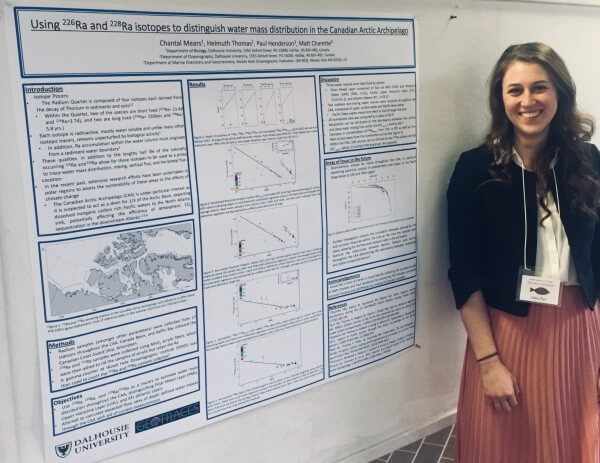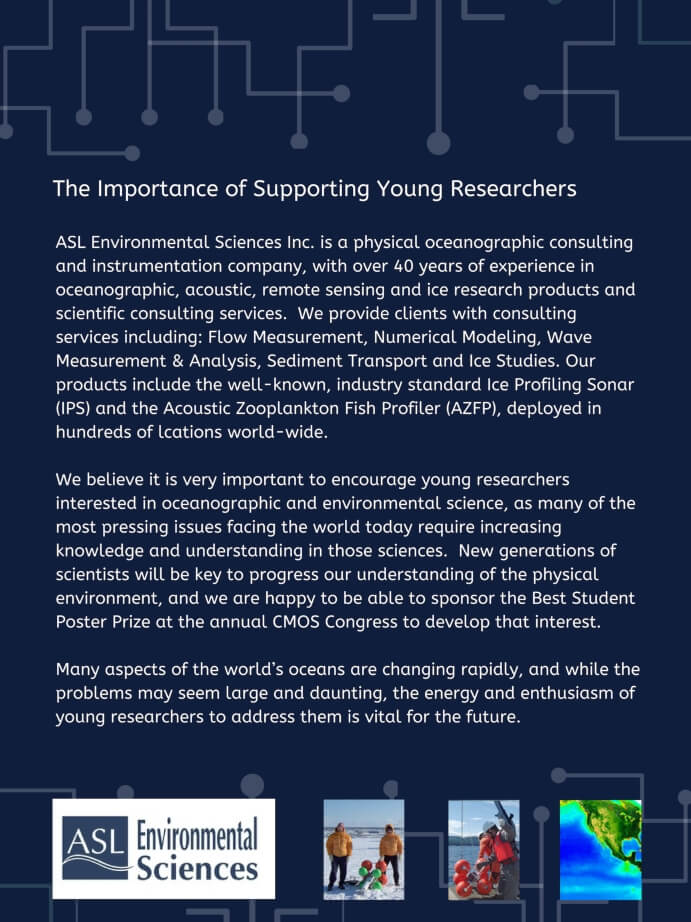
Supporting the Next Generation of Arctic Researchers
– By Chantal Mears, Dalhousie University, Halifax –
I had the pleasure of chatting with Dalhousie undergraduate student Chantal Mears at the 2018 CMOS Congress in Halifax. Chantal went on to win the ASL Environmental Sciences Best Student Poster prize (for her poster titled: Using 226Ra and 228Ra isotopes to distinguish water mass distribution in the Canadian Arctic Archipelago) at the congress, and I was not surprised. She is a great communicator and full of passion for her studies, and for working to support a better understanding of our oceans. Here, Chantal tells us a bit about the important work that she is involved with in understanding ocean dynamics in the Canadian Arctic.
Sarah Knight, CMOS Bulletin Editor
About The Project
Climate change headlines globally are emphasizing how deviations in environmental conditions can alter an area’s physical, geological, chemical, and biological processes, especially in susceptible regions like the Arctic. The Canadian Arctic, which provides a vital link between the North Pacific and North Atlantic via the Canadian Arctic Archipelago (CAA), is no exception. Spanning from 120°W-80°W, the CAA transits approximately 1/3 of the volume of the Arctic Ocean eastward to the North Atlantic (Coachman & Aagaard, 1974). This is of particular interest as the cool, low alkaline Arctic waters dispersed along the Eastern edge of the CAA into Baffin Bay are responsible for carbon sequestration, as well as instigating deep water formation and contributing to thermohaline circulation in the North Atlantic (eg. Aagaard & Carmack, 1989; Burt et al., 2016; Curry et al., 2011; Hamilton & Wu, 2013; Ingram & Prinsenberg, 1998; Rahmstorf, 2002; Shadwick et al., 2011). Furthermore, these key characteristics allow the CAA to have the potential to act as an early warning system for the effects of climate change globally.

Despite the region’s importance, the harsh and remote location of the CAA, as well as its complex bathymetry and topography, pose severe challenges to the understanding of the area’s regional oceanography and its responses to climate change (Ingram & Prinsenberg, 1998; Kliem & Greenberg, 2003; Melling, 2000). Our study combated this issue by using the two long-lived Radium (Ra) isotopes from the Radium Quartet, 226Ra and 228Ra (with half-lives of 1500yrs and 5.8yrs, respectively) as tracers for water mass origin and distribution (Charette et al., 2014, 2016; IAEA, 2011; Moore et al., 1980). These radio-isotopes make ideal tracers, as in addition to their long half-lives, they are mostly water soluble and unperturbed by biological activity. Therefore, the quasi- conservative 226Ra and 228Ra isotopes, which are produced by the decay of their largely particle bound Thorium parent isotopes (232Th and 230Th), are capable of tracking water mass dispersion away from coastal and shelf systems. With this understanding, and help from additional chemical constituents, our study was able to identify unique distribution patterns of the Ra isotopes as well as solidify previous findings related to the distinction between upper and lower water column, bulk flow patterns, as well as the connection between the Pacific and Atlantic water masses across the 200 isobath. To complement these results, a Principle Component Analysis (PCA) was preformed in order to provide new insights into the water masses and their unique flow patterns throughout the CAA. Lastly, the PCA was able to yield robust salinity based “apparent” end members for the Ra isotopes and some of the chemical constituents.
Moving forward I hope that this study can provide a springboard for future research initiatives, emphasizing the use of radioactive isotopes and trace metals to distinguish water mass distributions and ocean trajectories, thus, encouraging attentive focus to crucial keystone regions such as the Arctic and the long-term regional and global effects of climate change. I sincerely hope that my research has the opportunity to trigger changes even on the smallest scales, and is capable of inspiring and influencing future research in this important and vulnerable area of study.

An Undergraduate’s View of Research and Communication
Further pursuit of this project allowed me to attend the 2018 CMOS Congress in Halifax, where I won the ASL Environmental Sciences Best Student Poster prize. Being my first science conference, this was an exceptional opportunity to meet many brilliant researchers and learn about inspirational projects undertaken by students similar to myself from across Canada. This experience emphasized the importance of science communication, where although the majority of scientific research takes place in the field or behind a desk, effective communication is a critical step in broadcasting research. Due to this, I am extremely appreciative to have had the opportunity to refine my presentation skills, express my research to a panel of peers, gain insightful outlooks on my results, and establish crucial research connections, which lastly, I hope to be able to use in the future. Overall, my participation in the CMOS congress gave me an immense confidence boost, and further encouraged me to pursue a Masters in this field, which with luck I will be starting in the fall.
About Me
By definition, my undergraduate degree defines me as a biology student, but I am extremely grateful for the introduction to the world of chemical oceanography by Dr. Helmuth Thomas, who with the Canadian GEOTRACES initiative made this project possible for me. Particular thanks is awarded to Matt Charette and Paul Henderson at WHOI for analysing the samples collected in 2015 and now moving forward, aiding me in the publication process. Additionally I am also very grateful for the many staff in the Dalhousie Oceanography Department, who helped me tackle the countless unforeseen obstacles I encountered throughout this project. Without all this help, I would not have had the opportunity to pursue this project fully, explore in depth what results my data held, and above all learn a tremendous amount about science.
References
Aagaard, K., & Carmack, E. C. (1989). The role of sea ice and other fresh water in the Arctic circulation. Journal of Geophysical Research, 94(C10), 14485. https://doi.org/10.1029/JC094iC10p14485
Burt, W. J., Thomas, H., Miller, L. A., Granskog, M. A., Papakyriakou, T. N., & Pengelly, L. (2016). Inorganic carbon cycling and biogeochemical processes in an Arctic inland sea (Hudson Bay). Biogeosciences, 13(16), 4659–4671. https://doi.org/10.5194/bg-13-4659-2016
Charette, M. A., Morris, P. J., Henderson, P. B., & Moore, W. S. (2014). Radium isotope distributions during the US GEOTRACES North Atlantic cruises. Marine Chemistry, 177, 184–195. https://doi.org/10.1016/j.marchem.2015.01.001
Charette, M. A., Lam, P. J., Lohan, M. C., Kwon, E. Y., Hatje, V., Jeandel, C., et al. (2016). Coastal ocean and shelf-sea biogeochemical cycling of trace elements and isotopes: lessons learned from GEOTRACES. Philosophical Transactions of the Royal Society A: Mathematical, Physical and Engineering Sciences, 374(2081), 20160076. https://doi.org/10.1098/rsta.2016.0076
Coachman, L. K., & Aagaard, K. (1974). Physical Oceanography of Arctic and Subarctic Seas. In Marine Geology and Oceanography of the Arctic Seas (pp. 1–72). Berlin, Heidelberg: Springer Berlin Heidelberg. https://doi.org/10.1007/978-3-642-87411-6_1
Curry, B., Lee, C. M., & Petrie, B. (2011). Volume, Freshwater, and Heat Fluxes through Davis Strait, 2004-05*. Journal of Physical Oceanography, 11, 429–436. https://doi.org/10.1175/2010JPO4536.s1
Hamilton, J., & Wu, Y. (2013). Synopsis and trends in the physical environment of Baffin Bay and Davis Strait. Canadian Technical Report of Hydrography and Ocean Sciences, 282(282), 1–39.
IAEA. (2011). Analytical Methodology for the Determination of Radium Isotopes in Environmental Samples. Retrieved from https://www-pub.iaea.org/MTCD/Publications/PDF/IAEA-AQ-19_web.pdf
Ingram, R. G., & Prinsenberg, S. J. (1998). Coastal oceanography of Hudson Bay and surrounding eastern Canadian Arctic Waters Coastal Segment (26P). In A. R. Robinson & K. H. Brink (Eds.), The Sea (Vol. 11, pp. 835–861). New York: Wiley.
Kliem, N., & Greenberg, D. A. (2003). Diagnostic simulations of the summer circulation in the Canadian Arctic Archipelago. Atmosphere – Ocean, 41(4), 273–289. https://doi.org/10.3137/ao.410402
Melling, H. (2000). Exchanges of Freshwater Through the Shallow Straits of the North American Arctic. The Freshwater Budget of the Arctic Ocean, 479–502. https://doi.org/10.1007/978-94-011-4132-1
Moore, W. S., Feely, H. W., & Li, Y.-H. (1980). Radium isotopes in sub-Arctic waters. Earth and Planetary Science Letters, 49(2), 329–340. https://doi.org/10.1016/0012-821X(80)90076-X
Rahmstorf, S. (2002). Ocean circulation and climate during the past 120,000 years. Nature, 419(6903), 207–214. Retrieved from www.nature.com/nature
Shadwick, E. H., Thomas, H., Gratton, Y., Leong, D., Moore, S. A., Papakyriakou, T., & Prowe, A. E. F. (2011). Export of Pacific carbon through the Arctic Archipelago to the North Atlantic. https://doi.org/10.1016/j.csr.2011.01.014
More Like this:
ASL, Canadian Arctic, Chantal Mears, CMOS Congress, Poster Prize
